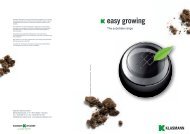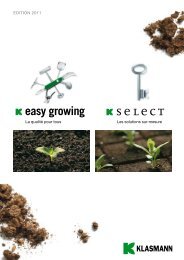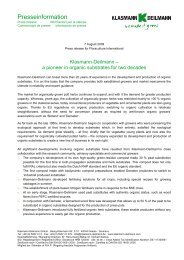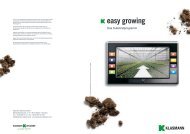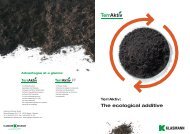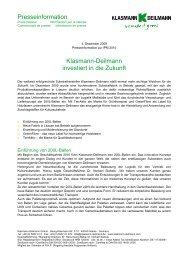Brochure on sustainability - Klasmann Deilmann
Brochure on sustainability - Klasmann Deilmann
Brochure on sustainability - Klasmann Deilmann
Create successful ePaper yourself
Turn your PDF publications into a flip-book with our unique Google optimized e-Paper software.
<strong>Klasmann</strong>-<strong>Deilmann</strong> is currently using 5,800 ha of extracti<strong>on</strong> areas in<br />
Lower Sax<strong>on</strong>y, for which after-use is specifi ed as follows:<br />
· 4,200 ha (72 %) for l<strong>on</strong>g-term re-waterlogging<br />
(of which 2,200 ha have already been re-waterlogged);<br />
· 1,500 ha (26 %) for agriculture<br />
(of which 900 ha have already been prepared);<br />
· 100 ha (2 %) for forestry.<br />
It is particularly noteworthy that, in almost all cases, it is the former<br />
peat extracti<strong>on</strong> areas that are being restored and will be preserved<br />
for c<strong>on</strong>servati<strong>on</strong> purposes in the l<strong>on</strong>g term. <strong>Klasmann</strong>-<strong>Deilmann</strong> is<br />
making a signifi cant c<strong>on</strong>tributi<strong>on</strong> here in terms of the ‘ecology’ pillar<br />
of <strong>sustainability</strong>.<br />
By c<strong>on</strong>trast, former peatlands that are used for other commercial<br />
sectors – such as agriculture – are no l<strong>on</strong>ger available for nature<br />
c<strong>on</strong>servati<strong>on</strong>.<br />
Re-waterlogging<br />
After peat producti<strong>on</strong> has ceased, the former extracti<strong>on</strong> areas are<br />
levelled and the drainage ditches fi lled in. Stepped dykes are built to<br />
create polders of 5 –10 ha in size which are used to regulate the level<br />
of rainwater. The aim is to encourage col<strong>on</strong>isati<strong>on</strong> by peat moss<br />
( Sphagnum) and other characteristic peatland plants such as cott<strong>on</strong><br />
grass to re-establish a typical bog landscape.<br />
In the re-waterlogged areas, the presence of standing water will lead to<br />
the former hydrological c<strong>on</strong>diti<strong>on</strong>s being re-established, resulting in<br />
bog-like vegetati<strong>on</strong> (i.e. restorati<strong>on</strong>) or even typical bogland vegetati<strong>on</strong><br />
(i. e. regenerati<strong>on</strong>) and can become CO2 sinks when the peat body<br />
begins to grow again. In this way, a re-waterlogged area can c<strong>on</strong>tribute<br />
to biodiversity – in this case, to the variety of ecosystems present – and<br />
again become a characteristic feature of the landscape.<br />
32 33



